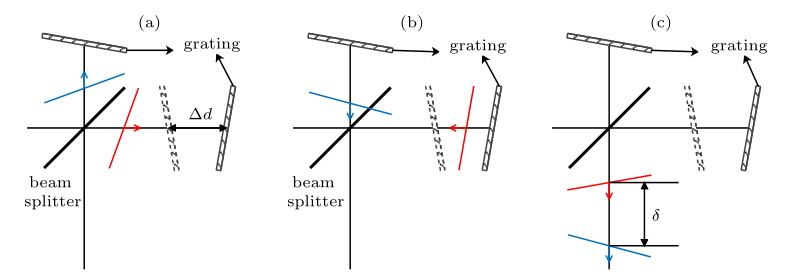On-orbit measurement of middle and upper atmospheric wind field provides critical data for several applications such as space society, global communication, weather forecasting. Over the last few decades, different techniques have been applied and multiple kinds of instruments have been launched for on-orbit wind observations. Doppler asymmetric spatial heterodyne spectroscopy (DASH) is recently developed and has become an interesting candidate. Compared with Michelson and Fabry–Perot techniques, DASH can be built in rugged and compact packages, and provides high et endue and multiline capability. Like other interference imaging techniques, DASH estimates wind velocity according to the Doppler shift of incident atmospheric emission line. The Doppler shift is determined by evaluating phase change of measured interferogram relative to the zero-wind reference.
However, the Doppler shift caused by atmospheric wind is rather weak. In order to measure the wind speed within useful precision (10 m/s or better), the challenge is to measure the position of one Doppler shifted line or more which has 1/3×10 7 or less of their wavelength. However, the temperature variety of environment introduces additional errors into phase measurements, such as change of Littrow wavenumber, thermally inducing phase offset and image shift. These effects result from the thermal dependence of interferometer components and structure. Effective analysis of phase sensitivity to instrument drift is necessary, and needs to solve the dependence of interferogram phase on all interferometer parameters above.
There have been several studies of accurate formula of DASH interferogram. In 2006, Englert et al. first developed the DASH concept and proposed an analytic formula of recorded interferogram. In this formula, the initial phase term depends on the optical path difference (OPD) offset and the difference between incident wavenumber and the Littrow wavenumber of diffraction gratings. In 2015, Fei et al. derived a new formula of DASH interferogram based on calculation of OPD. Their only difference is that the phase term is directly determined by incident wavenumber rather than wavenumber difference. In 2018, Liu et al. innovated the effective OPD to correct the phase term in filed-widened DASH (FW-DASH) configuration. It is worth mentioning that applying the effective OPD to wind retrieval produces a more.
accurate result. These researches determined the phase term theoretically by considering axial incident light. However, the optical path of off-axial incident light is different from that of axial light. In this way, the interferogram is also affected by field of view (FOV) of the interferometer.
Through tracing optical path and calculating OPD, not only axial but also off-axial formula of DASH interferogram is presented in this paper. And then the computational raytracing simulations and laboratory experiments provide practical specification that determines the dependence of interferogram phase on interferometer parameters. Discussion on phase decomposition of interferogram indicates that the initial phase term is extremely sensitive to instrument drifts, which shows the necessity of effective thermal control.

Schematic diagram of wavefronts movement approximation, where red and blue lines represent wavefronts and arrows denote the direction of approximated wavefronts. (Image by XIOPM)
Download: